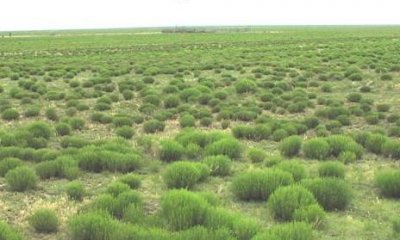
Deep Hardland 12-17" PZ
Scenario model
Current ecosystem state
Select a state
Management practices/drivers
Select a transition or restoration pathway
-
Transition T1A
Absence of disturbance and natural regeneration over time, may be coupled with excessive grazing pressure
More details -
Restoration pathway R2A
Adequate rest from defoliation and removal of woody canopy, followed by reintroduction of historic disturbance regimes
More details -
No transition or restoration pathway between the selected states has been described
Target ecosystem state
Select a state
State 1
Shortgrass State



Description
The reference plant community is a shortgrass dominated community with blue grama being the dominant grass with lesser amounts of buffalograss (average of 60-70% blue grama and 15-25% buffalograss). There are approximately 5% forbs and almost no woody shrubs or trees present.
Abusive grazing practices will shift this plant community to the Low Vigor Shortgrass (1.2) community. However, with prescribed grazing, the community will recover.
Blue grama and buffalograss will still dominate the site but total production will be reduced. The percent bare ground will start to increase. Broom snakeweed, cholla and other cacti species may increase on the site.
Submodel
Description
If long-term heavy grazing continues, a threshold will be crossed to a Shrub/Annuals Community (2.1). In this degraded state, blue grama loses its bunch grass characteristics and assumes a sod bound appearance because of grazing pressure. The shortgrass species are so resistant to grazing that it is uncommon for them to be killed out, but they can be weakened dramatically. Weedy and/or halfshrub species such as broom snakeweed may increase and dominate this site along with perennial threeawn and annuals. In the western portions of MLRA 77B, cholla and other cacti species may increase and possibly dominate the site.
Submodel
Mechanism
The shift from the Shortgrass State to the Shrubland State occurs due to heavy continuous grazing pressure, brush invasion, no fire, no brush management, and no pest management.
Mechanism
With the implementation of rangeland conservation practices such as Prescribed Grazing, Brush Management, Pest Management, and Range Planting, the Shrubland State can be able to revert back to the Shortgrass State.
Relevant conservation practices
| Practice | External resources |
|---|---|
|
Brush Management |
|
|
Prescribed Grazing |
|
|
Range Planting |
|
|
Integrated Pest Management (IPM) |
Model keys
Briefcase
Add ecological sites and Major Land Resource Areas to your briefcase by clicking on the briefcase (![]() ) icon wherever it occurs. Drag and drop items to reorder. Cookies are used to store briefcase items between browsing sessions. Because of this, the number of items that can be added to your briefcase is limited, and briefcase items added on one device and browser cannot be accessed from another device or browser. Users who do not wish to place cookies on their devices should not use the briefcase tool. Briefcase cookies serve no other purpose than described here and are deleted whenever browsing history is cleared.
) icon wherever it occurs. Drag and drop items to reorder. Cookies are used to store briefcase items between browsing sessions. Because of this, the number of items that can be added to your briefcase is limited, and briefcase items added on one device and browser cannot be accessed from another device or browser. Users who do not wish to place cookies on their devices should not use the briefcase tool. Briefcase cookies serve no other purpose than described here and are deleted whenever browsing history is cleared.
Ecological sites
Major Land Resource Areas
The Ecosystem Dynamics Interpretive Tool is an information system framework developed by the USDA-ARS Jornada Experimental Range, USDA Natural Resources Conservation Service, and New Mexico State University.


